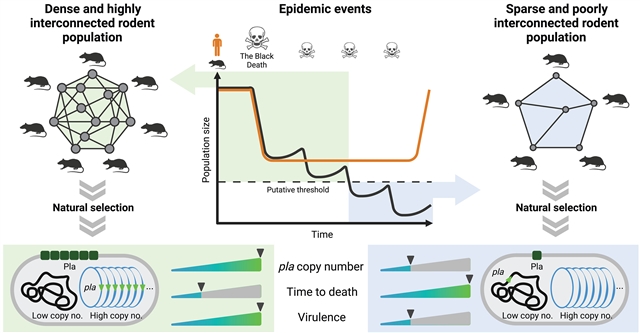
鼠疫耶尔森菌在三次鼠疫大流行中的毒力衰减,这一成果由加拿大麦克马斯特大学
该研究团队发现现代鼠疫杆菌菌株独立获得与古代菌株相同的pla损耗,并在此表明,从多拷贝pPCP1质粒中切除pla的同时,将含有pla的单独完整pPCP1整合到单拷贝pCD1质粒中,从而减少pla的剂量。
此外,该团队证明这种消耗降低了黑死病模型中小鼠的死亡率,但在肺和败血症形式的疾病中没有。该课题组人员假设,由于大流行导致死亡后啮齿动物碎片化,pla耗损可能在黑死病中选择性地对它们有利。
据了解,鼠疫耶尔森氏菌已经从野生啮齿动物宿主蔓延到共生啮齿动物和人类,引发了三次有历史记录的大流行。质粒编码的毒力基因pla拷贝数的减少发生在第一次和第二次大流行的后期菌株中,但pla缺失的生物学相关性一直难以测试。
附:英文原文
Title: Attenuation of virulence in Yersinia pestis across three plague pandemics
Author: Ravneet Kaur Sidhu, Guillem Mas Fiol, Pierre Lê-Bury, Christian E. Demeure, Emelyne Bougit, Rémi Beau, Charlotte Balière, Aurelia Kwasiborski, Valérie Caro, Jennifer Klunk, Daniel J. Salkeld, Ann Carmichael, Nükhet Varlk, Debi Poinar, David J. D. Earn, Benjamin M. Bolker, Jonathan Dushoff, G. Brian Golding, Nicolas Rascovan, Olivier Dussurget, Edward C. Holmes, Javier Pizarro-Cerdá, Hendrik N. Poinar
Issue&Volume: 2025-05-29
Abstract: Yersinia pestis has spilled over from wild rodent reservoirs to commensal rodents and humans, causing three historically recorded pandemics. Depletion in the copy number of the plasmid-encoded virulence gene pla occurred in later-dated strains of the first and second pandemics, yet the biological relevance of the pla deletion has been difficult to test. We identified modern Y. pestis strains that independently acquired the same pla depletion as ancient strains and herein show that excision of pla from the multicopy pPCP1 plasmid is accompanied by the integration of a separate full pPCP1 harboring pla into the single-copy pCD1 plasmid, reducing pla dosage. Moreover, we demonstrate that this depletion decreases the mortality of mice in models of bubonic plague but not in the pneumonic and septicemic forms of the disease. We hypothesize that pla depletion may have been selectively advantageous in bubonic plague, owing to rodent fragmentation after pandemic-induced mortality.
DOI: adt3880
Source: https://www.science.org/doi/10.1126/science.adt3880
